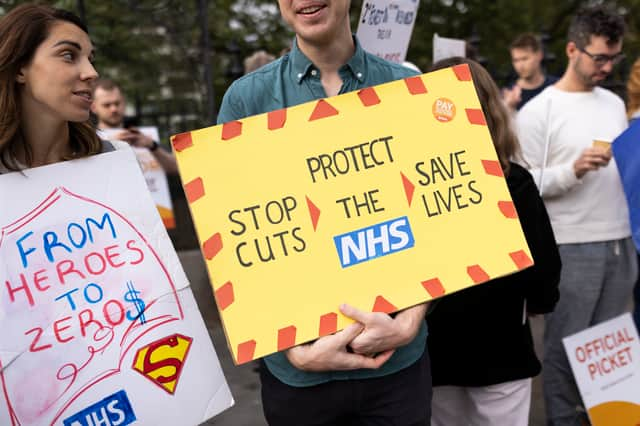Public sector workers are being made out to be the villains - no wonder staffing is taking an impact


New research by think tank Resolution Foundation has found the number of working days lost to striking has hit the highest level since the 1980s, with much of this industrial action focused in the public sector.
In fact, striking across major public sector areas such as the NHS, railways, Royal Mail and railways has made up 96% of all days lost to industrial action since major walkouts began in 2021.
Advertisement
Hide AdAdvertisement
Hide AdAlmost 3.9million working days have been lost over the past year, with workers in the NHS, Royal Mail, railways, schools and the Civil Service all taking part in action as they fight for pay increases and additional funding. The last time such a number was seen was in 1989, when 4.1m working days were lost amid strikes held nationwide by ambulance staff.
Resolution Foundation has pointed towards real-terms pay cuts being the major factor in staff taking industrial action. However biting cuts to budgets and threat of job cuts have also fuelled the disputes between workers, unions and the government.
While the government has come to an agreement with teachers with an offer of a 6.5% pay rise, many public sector workers are still fighting for their demands.
Junior doctors are due to walkout once again on Friday 18 August until the morning of Tuesday 22 August. The RMT union has announced a new walkout for 20,000 members from 14 train operating companies, targeting the August bank holiday weekend at the end of the month.
Advertisement
Hide AdAdvertisement
Hide AdIs it any surprise that staffing levels in our public sector are continuing to drop when workers - many of whom were hailed as "heroes" during the pandemic - are being treated as the "villians" in this saga?
Vacancies in the health, education and public administration sectors have increased by 33% since December 2019. Compared to the rest of the economy, which only saw a 23% increase, the answer is in the data when looking at the fact this government is failing to make these roles look attractive.
Teachers have left the sector in droves, citing significant cuts to education making their roles untenable. In data sourced from the Department for Education School Workforce Census, it showed around 44,000 teachers left the profession in 2022, a rise of 7,800 year-on-year and the highest rate from 2017/18, while overall staffing only rose by 1% with newly trained teachers beginning their career.
Likewise, around 20,000 more members of NHS staff left the profession in 2021/22 compared to the previous year. More than 41,000 nurses left their jobs in that same time period, the highest leaving rate in the past decade.
Advertisement
Hide AdAdvertisement
Hide AdGovernment rhetoric on the matter has recycled the same talking point that strikes are unproductive and are only targeting the public, with teachers putting the progress of students at risk or NHS staff pushing appointments even further back on waiting lists. Prime Minister Rishi Sunak has reiterated that the government will be taking a hard stance, specifically with NHS staff.
The government has pledged to jump-start the NHS again with a recruitment push. New plans unveiled by Health Secretary Steve Barclay showed that the government is attempting to introduce 360,000 extra staff members across the country by 2037, with pushes for new GP training places, nursing training places and other measures including cutting the training times for doctors in medical school to introduce staff to the NHS quicker.
However, the aim should be appreciating healthcare workers once they are in the roles. It's been evident from the reaction to strikes in the public sector, including the introduction of minimum service laws to reduce the impact of industrial action, that the government isn't realising the real reason for frustration and the bitter cycle of being unable to retain workers will continue.
Comment Guidelines
National World encourages reader discussion on our stories. User feedback, insights and back-and-forth exchanges add a rich layer of context to reporting. Please review our Community Guidelines before commenting.
